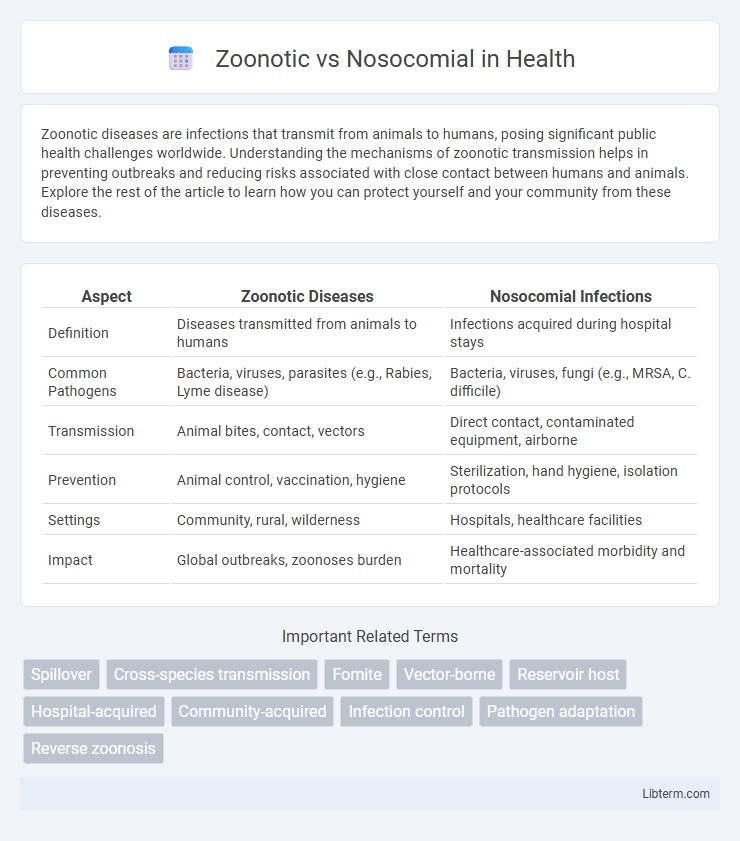Zoonotic diseases are infections that transmit from animals to humans, posing significant public health challenges worldwide. Understanding the mechanisms of zoonotic transmission helps in preventing outbreaks and reducing risks associated with close contact between humans and animals. Explore the rest of the article to learn how you can protect yourself and your community from these diseases.
Table of Comparison
| Aspect | Zoonotic Diseases | Nosocomial Infections |
|---|---|---|
| Definition | Diseases transmitted from animals to humans | Infections acquired during hospital stays |
| Common Pathogens | Bacteria, viruses, parasites (e.g., Rabies, Lyme disease) | Bacteria, viruses, fungi (e.g., MRSA, C. difficile) |
| Transmission | Animal bites, contact, vectors | Direct contact, contaminated equipment, airborne |
| Prevention | Animal control, vaccination, hygiene | Sterilization, hand hygiene, isolation protocols |
| Settings | Community, rural, wilderness | Hospitals, healthcare facilities |
| Impact | Global outbreaks, zoonoses burden | Healthcare-associated morbidity and mortality |
Introduction to Zoonotic and Nosocomial Infections
Zoonotic infections are diseases transmitted from animals to humans, caused by pathogens including viruses, bacteria, parasites, and fungi. Nosocomial infections, also known as healthcare-associated infections (HAIs), occur in patients during or after receiving medical care in hospitals or healthcare facilities. Understanding the distinct transmission routes and environments of zoonotic and nosocomial infections is essential for effective prevention and control strategies.
Defining Zoonotic Diseases: Animal-to-Human Transmission
Zoonotic diseases refer to infections that are transmitted directly or indirectly from animals to humans, involving pathogens such as bacteria, viruses, parasites, or fungi. These diseases, including rabies, Lyme disease, and avian influenza, pose significant public health challenges due to their potential for outbreaks and pandemics. Understanding zoonotic transmission pathways is crucial for controlling disease spread and implementing effective preventive measures in both animal and human populations.
Understanding Nosocomial Infections: Hospital-Acquired Risks
Nosocomial infections, also known as hospital-acquired infections (HAIs), occur during a patient's stay in healthcare facilities due to exposure to various pathogens such as bacteria, viruses, or fungi. Common examples include methicillin-resistant Staphylococcus aureus (MRSA), Clostridioides difficile, and catheter-associated urinary tract infections (CAUTIs), which thrive in environments with invasive procedures and compromised immune systems. Effective infection control protocols, including sterilization, hand hygiene, and patient isolation, are critical to reducing the incidence rates and protecting vulnerable populations within hospitals.
Key Differences Between Zoonotic and Nosocomial Infections
Zoonotic infections originate from animals and are transmitted to humans through direct contact, bites, or consumption of contaminated animal products, while nosocomial infections are acquired in healthcare settings due to exposure to pathogens via invasive procedures, contaminated equipment, or healthcare personnel. The key differences include the source of infection, with zoonotic diseases linked to animal reservoirs such as bats, rodents, or livestock, and nosocomial infections associated primarily with bacteria like MRSA, Clostridium difficile, or Pseudomonas aeruginosa thriving in hospitals. Prevention strategies differ significantly; zoonotic infections require controlling animal reservoirs and improving food safety, whereas nosocomial infections demand strict hygiene protocols, sterilization practices, and antimicrobial stewardship within healthcare facilities.
Common Examples of Zoonotic Diseases
Common examples of zoonotic diseases include rabies, Lyme disease, and salmonellosis, which are transmitted from animals to humans through bites, ticks, or contaminated food. Zoonotic pathogens often originate in wildlife, livestock, or pets, posing risks in both rural and urban environments. Understanding zoonotic diseases is crucial for preventing outbreaks and managing public health, distinguishing them from nosocomial infections that occur primarily in healthcare settings.
Prevalent Nosocomial Infections in Healthcare Settings
Prevalent nosocomial infections in healthcare settings primarily include bloodstream infections, urinary tract infections, surgical site infections, and ventilator-associated pneumonia, all caused by pathogens such as Staphylococcus aureus, Escherichia coli, and Pseudomonas aeruginosa. These infections result from factors like invasive procedures, prolonged hospital stays, and the use of indwelling medical devices, creating reservoirs for multidrug-resistant organisms. Effective infection control measures, including hand hygiene, sterilization protocols, and antibiotic stewardship, are critical to reducing the incidence of these healthcare-associated infections.
Transmission Pathways: From Animals vs. Healthcare Environments
Zoonotic diseases primarily transmit through direct contact with infected animals, bites, scratches, or through vectors like ticks and mosquitoes carrying pathogens from animals to humans. Nosocomial infections spread within healthcare environments via contaminated medical equipment, healthcare workers' hands, or invasive procedures exposing patients to bacteria, viruses, or fungi. Understanding the distinct transmission pathways--animal reservoirs versus hospital-based contamination--is crucial for targeted infection prevention and control strategies.
Prevention and Control Strategies for Zoonotic Diseases
Preventing zoonotic diseases requires integrated One Health approaches that include wildlife monitoring, livestock vaccination, and controlling vector populations to reduce disease transmission from animals to humans. Personal protective equipment (PPE), public education on hygiene practices, and strict biosecurity measures in farms and markets effectively minimize zoonotic spillover risks. Early detection through surveillance systems combined with rapid response protocols enhances containment and mitigates outbreaks of zoonotic infections.
Infection Control Measures for Nosocomial Infections
Nosocomial infections, also known as healthcare-associated infections (HAIs), require stringent infection control measures including hand hygiene, use of personal protective equipment (PPE), and sterilization of medical instruments to prevent pathogen transmission. Isolation protocols and surveillance systems are critical to detect and contain outbreaks within healthcare settings. Effective training of healthcare workers and adherence to guidelines from organizations like the CDC and WHO significantly reduce the incidence of nosocomial infections.
Public Health Impact: Addressing Both Zoonotic and Nosocomial Threats
Zoonotic diseases, transmitted from animals to humans, and nosocomial infections, acquired in healthcare settings, both pose significant public health challenges by contributing to morbidity, mortality, and healthcare costs globally. Effective public health strategies require integrated surveillance systems, antimicrobial stewardship, and infection control measures to mitigate zoonotic spillover events and prevent hospital-acquired infections. Addressing these threats involves multidisciplinary collaboration across veterinary medicine, epidemiology, and clinical healthcare to reduce transmission risks and enhance outbreak response capabilities.
Zoonotic Infographic

 libterm.com
libterm.com